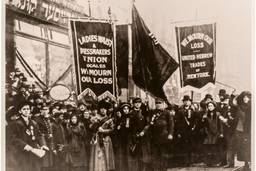
Chicago, Illinois—When the clock struck midnight on New Year’s Eve, 20,000 home healthcare workers in Illinois had an extra reason to celebrate. Thanks to a new contract negotiated by Service Employees International Union (SEIU) Local 880 and signed by Gov. Rod Blagojevich, homecare workers saw their hourly wage increase from $7.15 to $7.25. The raise, while small, was the second of a series that will bring the starting hourly wage to $9.35 by 2007.
“We’ve been fighting for the last 10 years for more money,” says SEIU member Diane Cunningham, who’s been a homecare worker for two decades. “I like working with elderly people, handicapped people. I’ve been doing this too long because I love it. I just don’t like the money.”
Illinois’ 37,000 homecare workers may provide vital day-to-day care and assistance for 67,000 state residents, but the majority still make poverty-level wages and receive no health benefits. A study released by Local 880 in April showed that Illinois ranked 44th nationwide in pay rates for homecare workers, with a median hourly wage of $6.60. Nearly half have no medical insurance. And in a survey conducted by SEIU, 49.4 percent said that in the past year they had to choose between buying food and paying utility bills.
Homecare workers might seem unlikely candidates for unionization. There is no shop floor, office or cafeteria where workers can share information and hold union meetings. But homecare workers are exactly the kind of new and rapidly growing workforce that has become SEIU’s priority. “It’s one of the fastest segments of the labor movement becoming organized,” says Local 880 organizer Cindy Boland. “What organizing has done anywhere is it takes an invisible workforce and makes it visible. That’s what we’re seeing in homecare.”
Illinois homecare workers are paid through two programs. The Department of Rehabilitation Services (DORS), supervised by the Department of Human Services, provides homecare to people with disabilities. While workers can be hired and fired by individual clients, they are paid by the state. For 20 years, Illinois’ Republican governors refused to recognize the bargaining rights of these workers, maintaining that their employers were their clients, despite the fact that the state was cutting the checks.
That changed this year, when Democrat Blagojevich signed legislation recognizing Local 880 as the bargaining unit for the state’s 20,000 DORS employees. “The fact that Blagojevich was elected was huge for us,” says Local 880 spokeswoman Marnie Goodfriend. “We’ve been organizing for 20 years and this is the first time we have a public sector bargaining unit.”
The Community Care Program is Illinois’ other homecare administrator. Run through the state’s Department of Aging, it provides care to low-income seniors. Unlike DORS, this program is managed and administered by private agencies contracted by the state to connect workers with clients. The state pays these agencies $11.06 an hour, and requires that 73 percent go to the worker.
But “to the worker” includes such things as worker’s comp, in-service trainings and even hepatitis shots, so the hourly wage often ends up being as low as $5.98. Having secured a new contract with the state for DORS workers, SEIU now is pressing for higher wages for homecare workers caring for the elderly through Community Care.
SEIU argues that investing more heavily in homecare workers in the Community Care program is not just the right thing to do, it makes good fiscal sense. Nursing home care currently costs the state about $28,000 a year per person, while homecare costs an average of about $4,000. Nikki Smith, a spokeswoman for the Department of Aging, says paying higher wages is in the state’s best interest. “I mean if you really want to be cold about it, in the long run it saves money, because it keeps people out of institutions,” she says.
The number of seniors in Illinois, and around the country, who will require homecare is going to balloon as baby boomers age. The Bureau of Labor Statistics estimates that direct care worker jobs in long-term-care settings will grow by about 800,000 jobs nationwide, or roughly 45 percent, by 2010. “The baby boomer generation is used to independence,” says Goodfriend. “They don’t want to go into nursing homes.”
Charles Johnson, director of the state’s Department of Aging, agrees. “I’ve never met an older person who couldn’t wait to get to the nursing home. People want to stay in their homes and I think it’s good public policy.”
In anticipation of the greater need for homecare, SEIU has significantly increased their homecare organizing efforts nationwide, with locals in eight states, including Pennsylvania, New York and California, where the union currently represents more than 180,000 home care workers. “There’s a homecare division in SEIU now,” says Boland, “that wasn’t there 10 years ago.”
“If you’re thinking long term,” says SEIU’s Wisconsin political director Robert Kraig, “these are jobs that can’t be exported overseas. The future of the labor movement isn’t industrial workers, it’s workers like homecare workers: people of color making seven dollars an hour with no health insurance.”
Gloria White, a steward with Local 880 who cares for the elderly deacon of her church on the city’s west side, says she looks forward to a day when homecare workers make a living wage.
“There’s gonna be more homecare workers, and I would like to see them make at least 10, 11, 12, 13 dollars an hour,” she says. “People forget that they’re gonna get old one day and they’re gonna need the help and they’re going to want the best.”
“We’ve been fighting for the last 10 years for more money,” says SEIU member Diane Cunningham, who’s been a homecare worker for two decades. “I like working with elderly people, handicapped people. I’ve been doing this too long because I love it. I just don’t like the money.”
Illinois’ 37,000 homecare workers may provide vital day-to-day care and assistance for 67,000 state residents, but the majority still make poverty-level wages and receive no health benefits. A study released by Local 880 in April showed that Illinois ranked 44th nationwide in pay rates for homecare workers, with a median hourly wage of $6.60. Nearly half have no medical insurance. And in a survey conducted by SEIU, 49.4 percent said that in the past year they had to choose between buying food and paying utility bills.
Homecare workers might seem unlikely candidates for unionization. There is no shop floor, office or cafeteria where workers can share information and hold union meetings. But homecare workers are exactly the kind of new and rapidly growing workforce that has become SEIU’s priority. “It’s one of the fastest segments of the labor movement becoming organized,” says Local 880 organizer Cindy Boland. “What organizing has done anywhere is it takes an invisible workforce and makes it visible. That’s what we’re seeing in homecare.”
Illinois homecare workers are paid through two programs. The Department of Rehabilitation Services (DORS), supervised by the Department of Human Services, provides homecare to people with disabilities. While workers can be hired and fired by individual clients, they are paid by the state. For 20 years, Illinois’ Republican governors refused to recognize the bargaining rights of these workers, maintaining that their employers were their clients, despite the fact that the state was cutting the checks.
That changed this year, when Democrat Blagojevich signed legislation recognizing Local 880 as the bargaining unit for the state’s 20,000 DORS employees. “The fact that Blagojevich was elected was huge for us,” says Local 880 spokeswoman Marnie Goodfriend. “We’ve been organizing for 20 years and this is the first time we have a public sector bargaining unit.”
The Community Care Program is Illinois’ other homecare administrator. Run through the state’s Department of Aging, it provides care to low-income seniors. Unlike DORS, this program is managed and administered by private agencies contracted by the state to connect workers with clients. The state pays these agencies $11.06 an hour, and requires that 73 percent go to the worker.
But “to the worker” includes such things as worker’s comp, in-service trainings and even hepatitis shots, so the hourly wage often ends up being as low as $5.98. Having secured a new contract with the state for DORS workers, SEIU now is pressing for higher wages for homecare workers caring for the elderly through Community Care.
SEIU argues that investing more heavily in homecare workers in the Community Care program is not just the right thing to do, it makes good fiscal sense. Nursing home care currently costs the state about $28,000 a year per person, while homecare costs an average of about $4,000. Nikki Smith, a spokeswoman for the Department of Aging, says paying higher wages is in the state’s best interest. “I mean if you really want to be cold about it, in the long run it saves money, because it keeps people out of institutions,” she says.
The number of seniors in Illinois, and around the country, who will require homecare is going to balloon as baby boomers age. The Bureau of Labor Statistics estimates that direct care worker jobs in long-term-care settings will grow by about 800,000 jobs nationwide, or roughly 45 percent, by 2010. “The baby boomer generation is used to independence,” says Goodfriend. “They don’t want to go into nursing homes.”
Charles Johnson, director of the state’s Department of Aging, agrees. “I’ve never met an older person who couldn’t wait to get to the nursing home. People want to stay in their homes and I think it’s good public policy.”
In anticipation of the greater need for homecare, SEIU has significantly increased their homecare organizing efforts nationwide, with locals in eight states, including Pennsylvania, New York and California, where the union currently represents more than 180,000 home care workers. “There’s a homecare division in SEIU now,” says Boland, “that wasn’t there 10 years ago.”
“If you’re thinking long term,” says SEIU’s Wisconsin political director Robert Kraig, “these are jobs that can’t be exported overseas. The future of the labor movement isn’t industrial workers, it’s workers like homecare workers: people of color making seven dollars an hour with no health insurance.”
Gloria White, a steward with Local 880 who cares for the elderly deacon of her church on the city’s west side, says she looks forward to a day when homecare workers make a living wage.
“There’s gonna be more homecare workers, and I would like to see them make at least 10, 11, 12, 13 dollars an hour,” she says. “People forget that they’re gonna get old one day and they’re gonna need the help and they’re going to want the best.”
Please consider supporting our work.

I hope you found this article important. Before you leave, I want to ask you to consider supporting our work with a donation. In These Times needs readers like you to help sustain our mission. We don’t depend on—or want—corporate advertising or deep-pocketed billionaires to fund our journalism. We’re supported by you, the reader, so we can focus on covering the issues that matter most to the progressive movement without fear or compromise.
Our work isn’t hidden behind a paywall because of people like you who support our journalism. We want to keep it that way. If you value the work we do and the movements we cover, please consider donating to In These Times.
Christopher Hayes is the host of MSNBC’s All In with Chris Hayes. He is an editor at large at the Nation and a former senior editor of In These Times.







